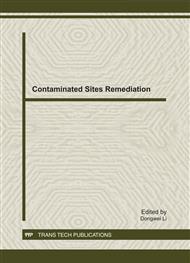p.63
p.68
p.76
p.83
p.88
p.93
p.99
p.106
p.111
The Remedial Effect of the Decomposing Bacteria on Different Petroleum Hydrocarbon Contamination
Abstract:
Petroleum contamination has become one of the major soil contaminations. Aiming at petroleum hydrocarbon contamination, the multi-group opposite experiments is set; this paper use some petroleum hydrocarbon-decomposing bacteria to remedy the soil contaminated by different carbon chain petroleum hydrocarbons. Compare and study the remedial results, and study the growth of the bacteria in the decomposing process. The Study shows that the degradation rate of the bacteria to short-chain petroleum hydrocarbons is relatively high; Within 40 days without nutrient substance, degradation rate of bacteria to gasoline and diesel is 80%, degradation rate of bacteria to aromatics and lubricants is 50%, the trend of bacteria’s growth curve and the degradation rate curve of each component are approximate.
Info:
Periodical:
Pages:
88-92
Citation:
Online since:
December 2011
Authors:
Price:
Сopyright:
© 2012 Trans Tech Publications Ltd. All Rights Reserved
Share:
Citation:


